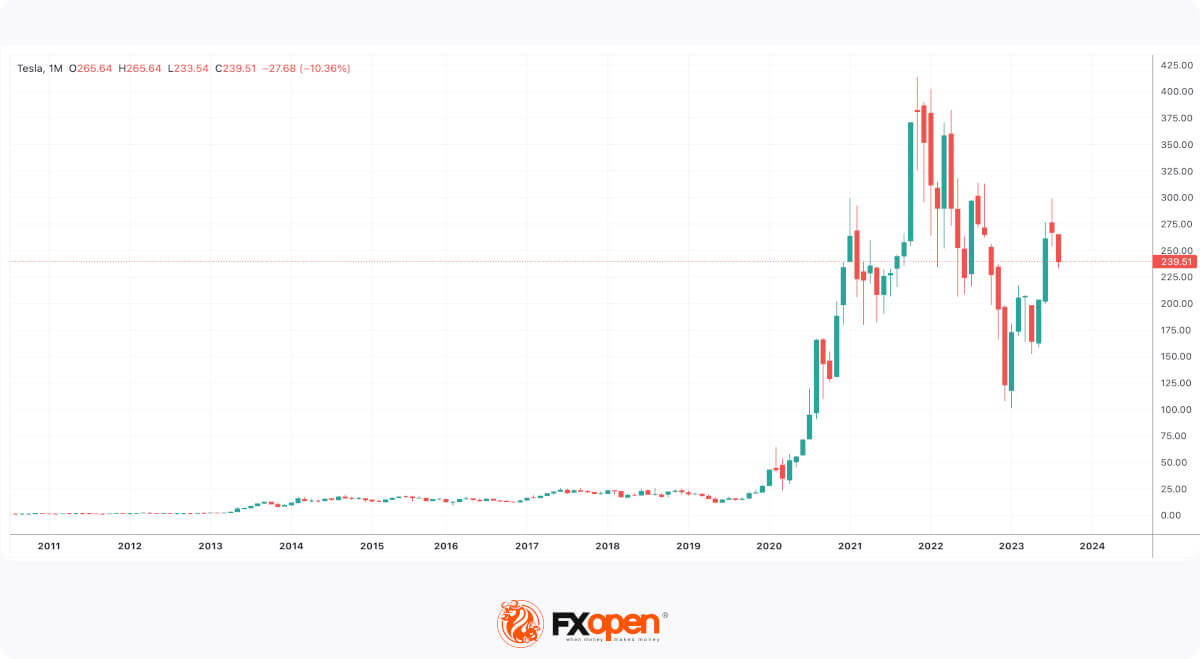Tesla Stock Hits One-Month Low: Analysing the Volatility Amidst Mixed Sentiments
Tesla, the electric vehicle (EV) pioneer and often considered synonymous with innovation, has witnessed a notable descent in its stock price over the past month. As a highly volatile player within the realm of big-cap publicly listed companies, Tesla’s recent decline of 17.8% has captured the attention of both investors and analysts alike. This article delves into the reasons behind this slump, highlighting the unique dynamics that define Tesla’s stock behaviour.

Tesla’s Notorious Volatility and Contextual Analysis
Tesla, a frontrunner in the EV market, has consistently been a stock that defies conventional norms of stability. It resides in the same category as tech giants such as Alphabet, Apple, and Facebook, even though its core business revolves around automobile manufacturing. This crossover has made Tesla subject to the capriciousness inherent in the tech sector. Thus, while a downward trajectory for over a month might be considered remarkable for more traditional sectors, it is not necessarily out of the ordinary for Tesla.
Evaluating Recent Stock Movement
At the end of the recent New York trading session, Tesla’s stock price closed at $238.70, marking a 1.63% decline compared to the beginning of the day. However, the more significant concern lies in its staggering 17.8% drop over the past 30 days, culminating in its current lowest point. This steady decline has prompted market participants to assess the factors contributing to this downturn.
Mixed Sentiments and Influencing Factors
The present market sentiment surrounding Tesla exhibits a dichotomy of optimism and pessimism, driven by recent developments and news items.
Optimistic Factors:
Elon Musk’s disclosure of updates related to Full Self-Driving (FSD) Beta versions 11.4.7 and 12 has added a glimmer of positivity. These updates underscore Tesla’s ongoing commitment to advancing autonomous driving technology. For a company synonymous with cutting-edge innovation, these strides can be seen as an indication of Tesla’s focus on technological leadership.
Pessimistic Factors
However, the crash, which involved a Tesla Model X, has injected a dose of negativity into the equation. It occurred in 2021, but footage of it has been released today to the mainstream media. The accident resulted in injuries to police officers and another individual. Of particular concern is the accident’s occurrence while the vehicle’s Autopilot system was active. This incident questions the reliability of Tesla’s autonomous driving systems and casts a shadow over its safety claims. The mishap’s implications extend beyond immediate safety concerns, affecting market confidence in the technology’s maturity.
Notably, reports of a severe crash involving Tesla’s Autopilot raise questions about the technology’s efficacy and safety. The accident’s occurrence, despite multiple warnings issued by the system, amplifies concerns over the robustness of the technology and the potential risks it poses to both occupants and pedestrians.
Potential Upswing Factors
While the current scenario is marked by uncertainty, potential factors for sentiment improvement are on the horizon. Tesla’s prospective investment in Indonesia to establish a battery factory signals its commitment to expansion and innovation. This investment hinges on nickel extraction and EV battery production, reaffirming the escalating demand for electric vehicles. As numerous manufacturers enter the EV market, Tesla’s investment in battery technology and the expansion of its production into new territories indicate an industry-wide shift toward electric transportation.
Conclusion
Tesla’s recent stock slump, though emblematic of its inherent volatility, is influenced by an intricate interplay of factors. The optimism stemming from technological advancements in autonomous driving contrasts with concerns raised by a recent accident involving Tesla’s Autopilot. Amid these fluctuations, external events continue to shape market sentiment. The potential investment in Indonesia and Tesla’s commitment to battery technology underline its pioneering role in the EV space.
In the face of these oscillating dynamics, Tesla stands at a crossroads where its ability to navigate these challenges and sustain its reputation for innovation will define its trajectory in both the stock market and the broader EV landscape.
This article represents the opinion of the Companies operating under the FXOpen brand only. It is not to be construed as an offer, solicitation, or recommendation with respect to products and services provided by the Companies operating under the FXOpen brand, nor is it to be considered financial advice.
The subject matter and the content of this article are solely the views of the author. FinanceFeeds does not bear any legal responsibility for the content of this article and they do not reflect the viewpoint of FinanceFeeds or its editorial staff.










